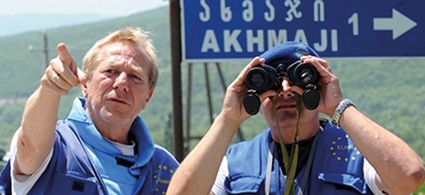New EUMM Bulletin on Communication & Conflict Prevention
The European Union Monitoring Mission (EUMM) in Georgia has released the latest edition of its regular bulletin ‘Monitor.' The bulletin is released periodically, generally once or twice a year, and outlines some aspects of the Mission’s activities or mandate.
The first issue was published in July 2016. The 6th edition, released this week to the public, is the first to be published this year and focuses on the Incident Prevention and Response Mechanism (IPRM) Meetings, and how they foster personal communication and face to face dialogue.
The meetings “allow participants from both sides of the Administrative Boundary Lines to talk to one another about security issues and other matters that affect people living along the Lines,” explains the bulletin.
It outlines the history of the IPRM, first agreed upon in February 2009, in Gali and Ergneti, and discusses three tools for incident prevention, incident response, and conflict resolution. On a larger scale, the bulletin demonstrates the three levels of conflict prevention, response, and resolution employed by the EUMM. At the first level is the ‘hotline,’ used daily; the second level is the IPRM Meetings in Gali and Ergneti, conducted monthly, and the highest level is the Geneva International Discussions, held four times a year.
The bulletin explains in more detail the use of the hotline used to communicate across the Administrative Boundary Lines (ABLs), to avoid a build-up of tensions that could lead to conflict. The hotline is used in many circumstances, including “detentions, access to emergency medical care, access to agricultural land and the effect on local residents of the installation of fences,
The hotline “is monitored by two holders who communicate with their counterparts via mobile phone, Skype, in technical meetings or in face-to-face discussions at the monthly meetings of the Incident Prevention and Response Mechanism in Gali and Ergneti.” Since the first call on the hotline in 2009, it has been activated more than 6,000 times.
The hotline was, in fact, put into use yesterday when five young hikers and a shepherd, all Georgian citizens, were detained by military forces from “South Ossetia” on charges that they had crossed the administrative boundary line illegally. The hikers are said to have been in Truso Gorge, a popular recreational area. This is the first report of people detained in that region – approximately 10 km from the administrative boundary line. Many Georgian tour groups and individual operators offer hiking tours to the Truso Gorge.
The EUMM Monitor aims “to provide the general public – in Georgia, the EU Member States and internationally – with wide-ranging and specific information about the work of the EUMM in Georgia.”
The latest issue of the Monitor can be accessed on the EUMM website, at www.eumm.eu/data/file/6440/The_EUMM_Monitor_issue_6_ENG.pdf
The EUMM was deployed to Georgia in September 2008 following the EU-brokered Six-Point Agreement that ended the August War between Russia and Georgia. It contributes to stabilization, normalization and confidence building between the conflict parties. The mission provides civilian monitoring of parties' actions, including full compliance with the Six-Point Agreement and subsequent implementing measures throughout Georgia. It also informs European policy in support of a durable political solution for Georgia.
By Samantha Guthrie












